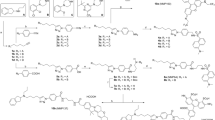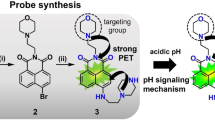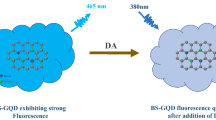Abstract
The use of semiconductor quantum dots (QDs) for bioimaging and sensing has progressively matured over the past decade. QDs are highly sensitive to charge-transfer processes, which can alter their optical properties. Here, we demonstrate that QD–dopamine–peptide bioconjugates can function as charge-transfer coupled pH sensors. Dopamine is normally characterized by two intrinsic redox properties: a Nernstian dependence of formal potential on pH and oxidation of hydroquinone to quinone by O2 at basic pH. We show that the latter quinone can function as an electron acceptor quenching QD photoluminescence in a manner that depends directly on pH. We characterize the pH-dependent QD quenching using both electrochemistry and spectroscopy. QD–dopamine conjugates were also used as pH sensors that measured changes in cytoplasmic pH as cells underwent drug-induced alkalosis. A detailed mechanism describing the QD quenching processes that is consistent with dopamine’s inherent redox chemistry is presented.
This is a preview of subscription content, access via your institution
Access options
Subscribe to this journal
Receive 12 print issues and online access
$259.00 per year
only $21.58 per issue
Buy this article
- Purchase on Springer Link
- Instant access to full article PDF
Prices may be subject to local taxes which are calculated during checkout





Similar content being viewed by others
References
Michalet, X. et al. Quantum dots for live cells, in vivo imaging, and diagnostics. Science 307, 538–544 (2005).
Klostranec, J. M. & Chan, W. C. W. Quantum dots in biological and biomedical research: Recent progress and present challenges. Adv. Mater. 18, 1953–1964 (2006).
Shim, M., Wang, C. J. & Guyot-Sionnest, P. Charge-tunable optical properties in colloidal semiconductor nanocrystals. J. Phys. Chem. B. 105, 2369–2373 (2001).
Anderson, N. A. & Lian, T. Q. Ultrafast electron transfer at the molecule-semiconductor nanoparticle interface. Annu. Rev. Phys. Chem. 56, 491–519 (2005).
Raymo, F. M. & Yildiz, I. Luminescent chemosensors based on semiconductor quantum dots. Phys. Chem. Chem. Phys. 9, 2036–2043 (2007).
Palaniappan, K., Hackney, S. A. & Liu, J. Supramolecular control of complexation-induced fluorescence change of water-soluble, beta-cyclodextrin-modified CdS quantum dots. Chem. Commun. 2704–2705 (2004).
Neuman, D. et al. Quantum dot fluorescence quenching pathways with Cr(III) complexes. Photosensitized NO production from trans-Cr(cyclam)(ONO)(2)(+). J. Am. Chem. Soc. 130, 168–175 (2008).
Medintz, I. L. et al. Interactions between redox complexes and semiconductor quantum dots coupled via a peptide bridge. J. Am. Chem. Soc. 130, 16745–16756 (2008).
Callan, J. F., Mulrooney, R. C., Kamila, S. & McCaughan, B. Anion sensing with luminescent quantum dots—a modular approach based on the photoinduced electron transfer (PET) mechanism. J. Fluor. 18, 527–532 (2008).
Dayal, S. et al. Observation of non-Forster-type energy-transfer behavior in quantum dot-pthalocyanine conjugates. J. Am. Chem. Soc. 128, 13974–13975 (2006).
Ruedas-Rama, M. J. & Hall, E. A. H. Azamacrocycle activated quantum dot for zinc ion detection. Anal. Chem. 80, 8260–8268 (2008).
Gill, R., Zayats, M. & Willner, I. Semiconductor quantum dots for bioanalysis. Angew. Chem. Int. Ed. 47, 7602–7625 (2008).
Gill, R. et al. Probing biocatalytic transformations with CdSe–ZnS QDs. J. Am. Chem. Soc. 128, 15376–15377 (2006).
Banerjee, S., Kar, S., Perez, J. M. & Santra, S. Quantum dot-based OFF/ON probe for detection of glutathione. J. Phys. Chem. C 113, 9659–9663 (2009).
Liu, X., Cheng, L. X., Lei, J. P. & Ju, H. X. Dopamine detection based on its quenching effect on the anodic electrochemiluminescence of CdSe quantum dots. Analyst 133, 1161–1163 (2008).
Yuan, J., Guo, W., Yang, X. & Wang, E. Anticancer drug-DNA interactions measured using a photoinduced electron-transfer mechanism based on luminescent quantum dots. Anal. Chem. 81, 362–368 (2009).
Uematsu, T., Waki, T., Torimoto, T. & Kuwabata, S. Systematic studies on emission quenching of cadmium telluride nanoparticles. J. Phys. Chem. C 113, 21621–21628 (2009).
Lee, K. R. & Kang, I. J. Effects of dopamine concentration on energy transfer between dendrimer-QD and dye-labeled antibody. Ultramicroscopy 109, 894–898 (2008).
Palaniappan, K., Xue, C. H., Arumugam, G., Hackney, S. A. & Liu, J. Water-soluble, cyclodextrin-modified CdSe–CdS core–shell structured quantum dots. Chem. Mater. 18, 1275–1280 (2006).
Clarke, S. J. et al. Photophysics of dopamine-modified quantumdots and effects on biological systems. Nature Mater. 5, 409–417 (2006).
Cooper, D. R. et al. Photoenhancement of lifetimes in CdSe/ZnS and CdTe quantum dot–dopamine conjugates. Phys. Chem. Chem. Phys. 11, 4298–4310 (2009).
Laviron, E. Electrochemical reactions with protonations at equilibrium. 10. The kinetics of the parabenzoquinone hydroquinone couple on a platinum-electrode. J. Electroanal. Chem. 164, 213–227 (1984).
Wraight, C. A. Proton and electron transfer in the acceptor quinone complex of photosynthetic reaction centers from Rhodobacter sphaeroides. Front. Biosci. 9, 309–337 (2004).
Patai, S. & Rappoport, Z. The Chemistry of the Quinonoid Compounds, Part I & II (John Wiley, 1988).
Finklea, H. O. Theory of coupled electron–proton transfer with potential-dependent transfer coefficients for redox couples attached to electrodes. J. Phys. Chem. B 105, 8685–8693 (2001).
Klegeris, A., Korkina, L. G. & Greenfield, S. A. Autoxidation of dopamine—a comparison of luminescent and spectrophotometric detection in basic solutions. Free Radic. Biol. Med. 18, 215–222 (1995).
Laitinen, H. A. & Harris, W. E. Chemical Analysis: An Advanced Text and Reference 2nd edn (McGraw-Hill, 1975).
Bailey, S. I. & Ritchie, I. M. A cyclic voltammetric study of the aqueous electrochemistry of some quinones. Electrochim. Acta 30, 3–12 (1985).
Costentin, C. Electrochemical approach to the mechanistic study of proton-coupled electron transfer. Chem. Rev. 108, 2145–2179 (2008).
Hay, S., Westerlan, K. & Tommow, C. Redox characteristics of a de novo quinone protein. J. Phys. Chem. C 111, 3488–3495 (2007).
Prasuhn, D. E. et al. Polyvalent display and packing of peptides and proteins on semiconductor quantum dots: Predicted versus experimental results. Small 6, 555–564 (2010).
Wang, H. Y., Sun, Y. & Tang, B. Study on fluorescence property of dopamine and determination of dopamine by fluorimetry. Talanta 57, 899–907 (2002).
Mancini, M. C., Kairdolf, B. A., Smith, A. M. & Nie, S. M. Oxidative quenching and degradation of polymer-encapsulated quantum dots: New insights into the long-term fate and toxicity of nanocrystals in vivo. J. Am. Chem. Soc. 130, 10836–10837 (2008).
Yuan, J., Guo, W. & Wang, E. Utilizing a CdTe quantum dots-enzyme hybrid system for the determination of both phenolic compounds and hydrogen peroxide. Anal. Chem. 80, 1141–1145 (2008).
Liu, X. & Ju, H. X. Coreactant enhanced anodic electrochemiluminescence of CdTe quantum dots at low potential for sensitive biosensing amplified by enzymatic cycle. Anal. Chem. 80, 5377–5382 (2008).
Schumb, W. C. Stability of concentrated hydrogen peroxide solutions. Ind. Eng. Chem. 41, 992–1003 (1949).
Korn, S. J. & Horn, R. Influence of sodium–calcium exchange on calcium current rundown and the duration of calcium-dependent chloride currents in pituitary cells, studied with whole cell and perforated patch recording. J. Gen. Physiol. 94, 789–812 (1989).
Medintz, I. L. & Mattoussi, H. Quantum dot-based resonance energy transfer and its growing application in biology. Phys. Chem. Chem. Phys. 11, 17–45 (2009).
Burda, C., Green, T. C., Link, S. & El-Sayed, M. A. Electron shuttling across the interface of CdSe nanoparticles monitored by femtosecond laser spectroscopy. J. Phys. Chem. B 103, 1783–1788 (1999).
Yarovoi, A. A. et al. Photo-induced electron transfer in CdSe nanocrystals passivated by quinone derivatives. Proc. SPIE 6728, 67282K (2007).
Lou, Y. B., Chen, X. B., Samia, A. C. & Burda, C. Femtosecond spectroscopic investigation of the carrier lifetimes in digenite quantum dots and discrimination of the electron and hole dynamics via ultrafast interfacial electron transfer. J. Phys. Chem. B 107, 12431–12437 (2003).
Long, D., Wu, G., Wang, W. & Yao, S. Photo-induced interfacial electron transfer from CdSe quantum dots to surface-bound p-benzoquinone and anthraquinone. Res. Chem. Intermed. 33, 655–661 (2007).
Marcus, R. A. & Sutin, N. Electron transfers in chemistry and biology. Biochim. Biophys. Acta 811, 265–322 (1985).
Clarke, S. J. Synthesis, Biological Targeting and Photophysics of Quantum Dots, Ch. 6. Ph.D. thesis. Department of Biomedical Engineering,McGill University (2008).
Clarke, S. J., Hollmann, C. A., Aldaye, F. A. & Nadeau, J. L. Effect of ligand density on the spectral, physical, and biological characteristics of CdSe/ZnS quantum dots. Bioconjugate Chem. 19, 562–568 (2008).
Mei, B. C. et al. Modular poly(ethylene glycol) ligands for biocompatible semiconductor and gold nanocrystals with extended pH and ionic stability. J. Mater. Chem. 18, 4949–4958 (2008).
Mei, B. C. et al. Effects of ligand coordination number and surface curvature on the stability of gold nanoparticles in aqueous solutions. Langmuir 25, 10604–10611 (2009).
Aldana, J., Lavelle, N., Wang, Y. J. & Peng, X. G. Size-dependent dissociation pH of thiolate ligands from cadmium chalcogenide nanocrystals. J. Am. Chem. Soc. 127, 2496–2504 (2005).
Parak, W. J. et al. Biological applications of colloidal nanocrystals. Nanotechnology. 14, R15–R27 (2003).
Jeong, S. et al. Effect of the thiol–thiolate equilibrium on the photophysical properties of aqueous CdSe/ZnS nanocrystal quantum dots. J. Am. Chem. Soc. 127, 10126–10127 (2005).
Cai, P. & Snyder, J. K. Preparation, reactivity and neurotoxicity of tryptamine-4,5-dione. Tetrahedron Lett. 31, 969–972 (1990).
Shamsipur, M., Kazemi, S. H., Alizadeh, A., Mousavi, M. F. & Workentin, M. S. Self-assembled monolayers of a hydroquinone-terminated alkanethiol onto gold surface. Interfacial electrochemistry and Michael-addition reaction with glutathione. J. Electroanal. Chem. 610, 218–226 (2007).
Huang, X., Xu, R., Hawley, M. D., Hopkins, T. L. & Kramer, K. J. Electrochemical oxidation of n-acyldopamines and regioselective reactions of their quinones with n-acetylcysteine and thiourea. Arch. Biochem. Biophys. 352, 19–30 (1998).
Freeman, R. et al. Biosensing and probing of intracellular metabolic pathways by NADH-sensitive quantum dots. Angew. Chem. Int. Ed. 48, 309–313 (2009).
Freeman, R. & Willner, I. NAD(+)/NADH-sensitive quantum dots: Applications to probe NAD(+)-dependent enzymes and to sense the RDX explosive. Nano Lett. 9, 322–326 (2009).
Tomasulo, M., Yildiz, I. & Raymo, F. M. pH-sensitive quantum dots. J. Phys. Chem. B 110, 3853–3855 (2006).
Snee, P. T. et al. A ratiometric CdSe/ZnS nanocrystal pH sensor. J. Am. Chem. Soc. 128, 13320–13321 (2006).
Chen, Y., Thakar, R. & Snee, P. T. Imparting nanoparticle function with size-controlled amphiphilic polymers. J. Am. Chem. Soc. 130, 3744–3745 (2008).
Zhang, F. et al. Ion and pH sensing with colloidal nanoparticles: Influence of surface charge on sensing and colloidal properties. ChemPhysChem 11, 730–735 (2010).
Dabbousi, B. O. et al. (CdSe)ZnS core–shell quantum dots: Synthesis and optical and structural characterization of a size series of highly luminescent materials. J. Phys. Chem. B 101, 9463–9475 (1997).
Aziz, M. Z., Selvaraju, T. & Yang, H. Selective determination of catechol in the presence of hydroquinone at bare indium tin oxide electrodes via peak-potential separation and redox cycling by hydrazine. Electroanalysis 14, 1543–1546 (2007).
Sapsford, K. E. et al. Monitoring of enzymatic proteolysis on a electroluminescent-CCD microchip platform using quantum dot–peptide substrates. Sens. Actuat. B 139, 13–21 (2009).
Sapsford, K. E. et al. Kinetics of metal-affinity driven self-assembly between proteins or peptides and CdSe–ZnS quantum dots. J. Phys. Chem. C 111, 11528–11538 (2007).
Medintz, I. L. et al. Proteolytic activity monitored by fluorescence resonance energy transfer through quantum-dot–peptide conjugates. Nature Mater. 5, 581–589 (2006).
Acknowledgements
The authors thank T. O’Shaughnessy and I. Willner for helpful suggestions and acknowledge the CB Directorate/Physical S&T Division (DTRA), ONR, NRL and the NRL-NSI for financial support. M.H.S. acknowledges an NRC fellowship through NRL. J.B.B-C. acknowledges a Marie Curie International Outgoing Fellowship.
Author information
Authors and Affiliations
Contributions
I.L.M., M.H.S. and S.A.T. conceived of the experimental strategy and carried out experiments. J.B.B-C. and P.E.D. designed and synthesized the peptides used. K.S., B.C.M. and M.H.S. synthesized QD material. M.H.S. synthesized the dopamine isothiocyante. K.S. and H.M. analysed experimental results. J.B.D. grew cell cultures and assisted with cellular experiments. J.S.M. carried out fluorescence lifetime experiments.
Corresponding author
Ethics declarations
Competing interests
The authors declare no competing financial interests.
Supplementary information
Supplementary Information
Supplementary Information (PDF 1956 kb)
Rights and permissions
About this article
Cite this article
Medintz, I., Stewart, M., Trammell, S. et al. Quantum-dot/dopamine bioconjugates function as redox coupled assemblies for in vitro and intracellular pH sensing. Nature Mater 9, 676–684 (2010). https://doi.org/10.1038/nmat2811
Issue Date:
DOI: https://doi.org/10.1038/nmat2811
This article is cited by
-
Fluorometric Assay of Tyrosinase and Atrazine Based on the Use of Carbon Dots and the Inhibition of Tyrosinase Activity
Journal of Fluorescence (2024)
-
Rational Design of Capping Ligands of Quantum Dots for Biosensing
Chemical Research in Chinese Universities (2024)
-
Gold nanoparticles-decorated peptide hydrogel for antifouling electrochemical dopamine determination
Microchimica Acta (2023)
-
Highly sensitive and selective detection of dopamine with boron and sulfur co-doped graphene quantum dots
Scientific Reports (2022)
-
Bioelectronic control of a microbial community using surface-assembled electrogenetic cells to route signals
Nature Nanotechnology (2021)



